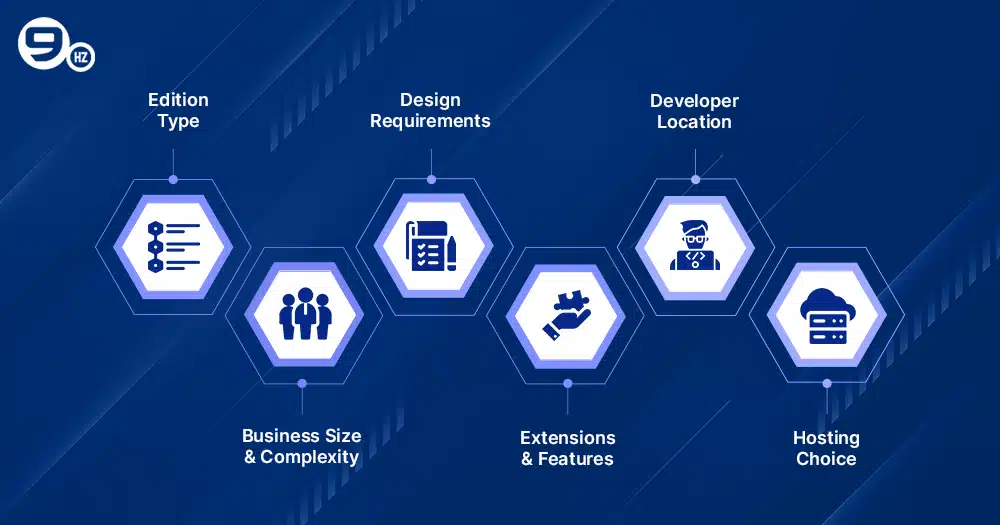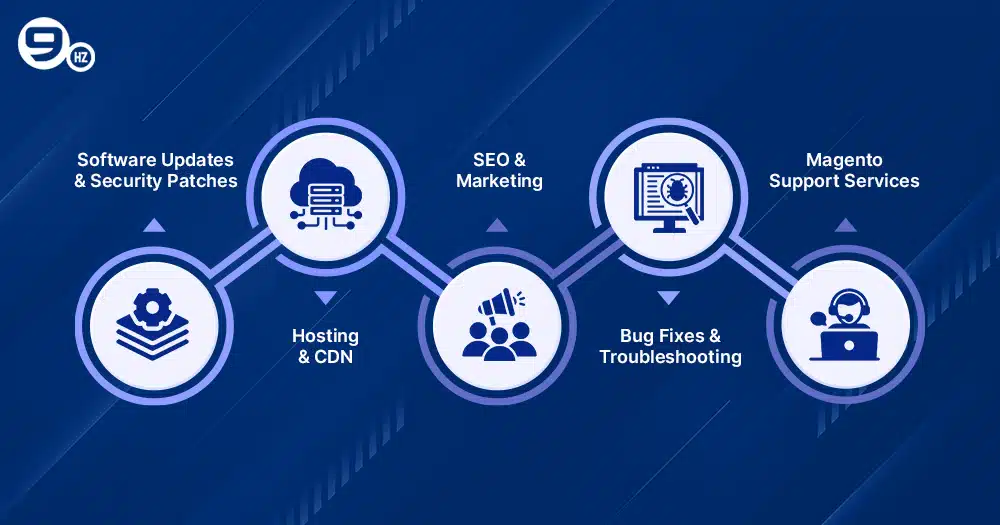Imagine building a powerful eCommerce website with endless customizing, comfort, and scalability; but with so many Magento pricing plans, how would you know where to start?
From startups to big corporations, Magento, a product from Adobe Commerce, is a top eCommerce development platform used by companies. It is, in fact, the global market for e-commerce platforms, which was valued at USD$ 8.58 billion in 2024, and it is anticipated that it will grow at a CAGR of 18.1% during the forecast period of 2024–2030, ushering in innovations such as strong demand solutions like Magento. But before you go ahead and make your dream website, understanding the pricing structure of Magento is important.
The Magento eCommerce pricing for Community Edition, smaller online store, larger online store or for Commerce Cloud Edition, may differ dramatically. While building a Magento store you have to pay for everything such as licensing fees, custom development, and maintenance.
So let’s drive down through the development process to maintenance so that you can set your budgeting with clarity.
Magento Pricing Breakdown: Magento Website Development Cost
You need to understand Magento pricing before you set up your Magento store. Your overall Magento costs will change depending on your organization size, functionalities, and hosting needs, regardless of your choice between the Community Edition or investing in the Commerce Cloud edition.
From the Magento license cost to the Magento development services price and even managed Magento hosting, every single element has a considerable contribution to make in shaping the overall budget. Let’s delve into the detailed costs of a Magento ecommerce website.
| Cost Component | Estimated Magento Price Range |
|---|---|
| Magento Open Source (Free) | $0 |
| Magento Commerce/Adobe Commerce License | $20,000 – $125,000/year |
| Magento Enterprise Edition | Starts from $25,000/year |
| Magento Hosting Cost | $100 – $5,000/month (varies by provider) |
| Domain Name | $100 – $500/year |
| Magento Theme | $0 – $500+ |
| Custom Magento Extension | $50 – $5,000+ |
| Magento Developer Cost | $50 – $200/hour |
| Magento Web Design Cost | $1,000 – $10,000+ |
| SSL Certificate | $50 – $300/year |
| Payment Provider Fees | Varies, e.g., $0.30 per transaction |
| SEO and Promotion Services | $500 – $5,000/month |
| Maintenance Services | $500 – $6,000/month |
| Magento Support | $1,000 – $5,000/year |
Let’s now dissect each of these cost components related to operating and constructing a Magento website to see where you will be spending your money.
1. Magento Edition Licensing
The chosen Magento version affects the pricing. For instance, while Magenta Open Source provides a free version, both Magento Commerce and Magento Cloud call for yearly subscription payments.
Moreover, it is said that an annual charge of $22,000 is necessary for corporate pricing using Magento but the pay increases with the expansion of the ecommerce platform and the need for its extra capabilities.
- Magento Open Source (formerly Community Edition): Free to use. Ideal for small ecommerce stores just starting out.
- Magento Commerce (Adobe Commerce): The advanced, paying version comes with many more features, including B2B, performance improvements, and analytics.
- Magento Commerce Cloud: Everything under Magento Commerce along with AWS or Azure managed cloud hosting.
Note: Magento Commerce cloud pricing is based on annual gross revenue. The Magento Enterprise pricing starts at around $22,000/year but can reach $125,000 for any large store.
2. Hosting Costs
Next, think about your the cost of hosting, which will vary depending on whether you are using shared hosting, VPS, dedicated, or cloud hosting. With Magento Commerce Cloud, doing hosting is required.
Other than this, hosting cost types vary between $10 and $5,000/month. Managed solutions allow enhanced Magento performance optimization and security, mainly for mature ecommerce platforms that require scalability and speed.
- Hosting provider
- Server specifications
- Traffic volume
Average hosting costs are $10/month (shared hosting prices) and $5,000/month (dedicated enterprise hosting).
Get a Custom Magento Store Built for Your Business
3. Magento Developer Cost
Qualified Magento developers are a prerequisite for the complete Magento e-commerce solution. Hourly rates of around $20–$200 primarily depend on the level of expertise and geographical location of a particular developer.
Hiring expert developers ensures the long-term integrity of the project and fewer bugs due to the complexity of Magento development; hence, it is crucial for the high performance of an online store in the competitive ecommerce space today.
- Freelancers: $20 – $100/hour
- Agencies: $75 – $200/hour
Normal development hours can vary from 200 to 500+ for an average Magento store. Hence, the total development cost can vary from $10,000 to $100,000+.
4. Themes and Design
Moreover, as design directly links to user experiences, it is rather crucial to decide the budget needed for choosing or personalizing a Magento theme. Either go for a premium Magento theme pricing or choose free themes. Either way, responsive and search-engine-optimized templates for your ecommerce site are a must.
- Free themes
- Paid themes from the Magento marketplace
- Custom designs tailored for your brand
Prices of Magento themes range from $50 to $500 for premium ones. Custom Magento web design costs may exceed $10,000 for unique designs. Choosing a responsive, SEO-friendly theme can boost the performance and visibility of your e-commerce site.
5. Extensions and Integrations
CRM, ERP, shipping, and marketing tools typically use extensions. Some Magento marketplace items are free, but others cost $50 to thousands. Besides, there are businesses that usually develop customized Magento extensions to fit their specific needs. These tools aim to enhance your Magento store flexibly as it evolves.
- Marketplace extensions
- Custom-built modules
Magento extensions can cost anywhere from $50 to a few thousand dollars, especially in cases involving CRM, ERP, or PIM integrations. When you purchase them from the Magento market, consider compatibility and update frequency.
6. Domain Name and SSL Certificate
Even a simple, but recurring, component would include an entire domain name and SSL certificate in your Magento e-commerce expense. Domains are generally about $10-$500 per year, whereas Magento SSL cost range from $50-$300/domain.
Though several hosting companies give SSL certificates free of charge, it is essential to ensure that a certificate is attached for the protection of the Magento site and for this purpose to improve customer confidence.
- A domain name ($10–$500/year)
- An SSL certificate ($50–$300/year)
SSL is also relevant for SEO rankings, as with security. Find out if your hosting plan comes with free SSL features.
7. Payment Gateway Fees
Whatever pricing plan you take for Magento, there is a fee for connecting to payment service providers. A typical example would be that Stripe or PayPal charges something like $0.30, plus a certain percentage per transaction.
These small charges can quickly accumulate, particularly in high-volume transactional e-commerce businesses. It is, therefore, prudent to run some calculations on them well in advance of budgeting for your Magento shop.
Start Your Magento Project with Certified Developers
8. SEO, Marketing & Promotion
Set aside funds for SEO and advertising to raise profiles and boost sales. Depending on the scale, marketing may run monthly between $500 and $5,000.
This covers sponsored commercials, social media, and content marketing. Optimizing a Magento site results in higher visibility in search engine results, which increases the possible traffic to an online retailer.
- SEO and promotion services
- Email and social media marketing
- Paid advertising
9. Support and Maintenance
Ongoing maintenance and support keep your Magento website running. Monthly maintenance services generally consist of updates, backups, and security patches and could range anywhere between $500 and $6,000.
Maintenance is vital, whether you use Enterprise Edition or Magento Open Source, to avoid downtimes and to ensure that your ecommerce business runs smoothly at all times.
- Monthly maintenance cost: $500–$6,000
- Includes bug fixes, upgrades, and backup
Factors Influencing the Magento Pricing
Magento price covers more ground than just licensing costs. Whether it is the category of your edition, the complexity of your online shop, or outside services engaged, many elements define what you will really be spending on your Magento e-commerce site.
Moreover, the selection of developers, custom extensions, and hosting can significantly increase the overall Magento cost. The following sections will highlight the most significant influences of the Magento pricing on the e-commerce website to help you budget more wisely.
1. Edition Type: Open Source vs Commerce vs Cloud
The Magento Community Edition is free, but the Magento Commerce and Commerce Cloud editions charge a license fee depending on what is required. Depending on one’s needs, the Magento cost will increase significantly based on the features and pricing plans chosen.
- Magento Community Edition is an open-source offering free of charge but is not equipped with enterprise-level features.
- Magento Commerce Cloud edition comes with hosting and tools, which should be enough to limit expenses with third-party solutions.
2. Business Size & Complexity
The larger the business, the higher the demand for sophisticated features, multiple integrations, and high-level security. This is the reason that the Magento enterprise cost for such companies is much higher than that of smaller stores that follow the Magento open-source version. More sophisticated stores take more time and development resources.
- For small businesses, basic functionality may be all that is required.
- Enterprises may require custom integration, multilingual support, and multiple storefronts.
- The more complex the requirement, higher the Magento pricing of a ecommerce business will be.
3. Design Requirements
If you’re seeking to establish a unique brand experience, the expenses associated with Magento web design can be quite high. Templates from the Magento market are inexpensive, but many choose custom Magento themes to stand out in a crowded ecommerce platform landscape.
Schedule Your Free Magento Consultation Today!
4. Extensions and Features
Adding robust functionality through Magento extensions or creating custom Magento extensions will only add to your total investment in Magento e-commerce. They, however, make your store more efficient, improve customer experience, and offer competitive advantages for your e-commerce business. For example:
- Real-time shipping calculations
- Multi-warehouse inventory management
- AI-powered product recommendations
5. Developer Location
Regional differences in Magento pricing apply to this business. The United States-based developers charge a premium as compared to teams in Eastern Europe or Asia. Offshore developers are a bargain, provided they can deliver quality work for your Magento store.
6. Hosting Choice
Your choice of shared hosting, VPS, or online hosting greatly affects your Magento pricing for hosting. Magento prices include hosting, while other editions come with separate Magento hosting prices, which vary greatly according to store traffic and performance needs.
- Shared hosting may be enough for startups.
- High-traffic stores require cloud hosting solutions that will scale.
How Much Does it Cost to Maintain a Magento eCommerce Store?
We have already launched an online store in Magento. Maintenance remains of utmost importance for continued success. The much-needed updates, checks on security, and optimizations will help keep your store running smoothly in case of any issues. These calculations will affect Magento pricing over time: performance, security, and customer satisfaction.
The Magento pricing does not stop at development; further considerations for hosting, updates, marketing, and support must also be factored into maintaining your Adobe commerce store. Let’s take a closer look at some of the recurring costs for a Magento e-commerce website.
1. Software Updates and Security Patches
It is imperative to maintain your Magento site. Regular updates serve to fix vulnerabilities that your store might be exposed to, and they might even improve your store’s performance. This is especially true for those using Magento Enterprise Edition, where advanced features require some degree of monitoring.
Estimated Cost: $300 – $1,500/month
Expert developers or Magento application support teams may charge between $300 and $1500 per month to handle these updates, patches, upgrades, and other related tasks. However, if you decide not to apply these updates, performance issues are likely to arise, not to mention authorities gaining access to your store—almost exclusively if your Magento SSL or security module has actually expired.
2. Hosting and CDN
Performance is reliant totally on hosting. For businesses using the Magento Cloud edition, the solution will indeed be built-in cloud hosting. Others need to procure a third-party managed Magento hosting provider. The cost of hosting varies anywhere between $50 and $5,000 a month, depending on traffic, speed requirements, and the location of the hosting server.
Estimated Cost: $50 – $5,000/month
The other alternative to increase speed—thus preventing cart abandonment on your e-commerce site—is to add a Content Delivery Network (CDN). In the Magento market, commonly used CDNs are Cloudflare, AWS, and Fastly.
3. SEO & Marketing
To keep consistent traffic in your Magento store, you need to continually invest in SEO and other promotional services that include keyword optimization, backlinking, email campaigns, and ad management. On average, businesses spend anywhere from $500 to $5,000/month depending on the goal set out for their e-commerce business.
Estimated Cost: $500 – $5,000/month
On another note, for a better ROI, integrating Google Analytics and marketing automation tools along with custom Magento extensions helps track those campaigns’ performances and improve them.
4. Bug Fixes & Troubleshooting
There are times, in spite of all possible attempts when a few bugs crop up after all. These bugs might show up due to different reasons, like expiration of the domain concerned, buggy Magento extensions, or discretion play of one or other conflicts invoked by third-party apps. Therefore, we must promptly resolve these issues to sustain operations and avoid customer disengagement.
Estimated Cost: $100 – $2,000/month
Typically, bug fixes are charged within the range of $100-$2,000 per month, depending on their complexity. Retailers who are using the Enterprise Edition often resort to signing contracts with agencies offering priority support and performance tuning for Magento.
5. Magento Support Services
Some prefer dedicated Magento support plans, allowing peace of mind. Besides routine monitoring and daily backups, emergency help is also included. Officially, Magento Commerce and Magento Commerce Cloud are supported by Adobe commerce cloud, but some may choose a third-party agency for more affordable and flexible options.
Depending on your store size, Magento support services may cost $1,000 to $5,000/year, ensuring that your Magento shop remains stable, secure, and profitable.
Conclusion
Thus, there is no fixed price; it depends on your business requirements, goals, and the Magento pricing plan itself. Whether you go with Community Edition or get into the rich features of the Magento Commerce Cloud, every part of your development, Magento hosting, themes, and support and maintenance adds up to your overall cost.
However, e-commerce development can actually make your dream project work if you plan and deal with competent developers. Ultimately, Magento e-commerce would be worth the investment for businesses that want any online store to be scalable, customizable, and high-performing—all on a proven and powerful ecommerce platform.
FAQs
1. What does Magento cost per month?
Magento pricing depends upon the edition as well as the business requirements. The Magento Open Source edition is free, while Magento Commerce prices start at practically $22,000 per year and go well beyond $100,000 a year for large enterprises.
Additional costs incurred are for hosting Magento, developing custom Magento extensions, design, support, and maintenance, which can add heavily to the overall investment that goes into a Magento e-commerce website.
2. Why is Magento so expensive?
Magento is expensive because it is powerful, scalable, and feature-rich, making it very flexible and growth-oriented. Licensing fees for Magento Commerce Cloud or Magento Enterprise Edition, coupled with custom development, hosted Magento, and continuous support and maintenance, are the factors that increase expenditures.
Lastly, building or maintaining a Magento store would generally need many experienced developers with advanced integrations and Magento performance optimization, all contributing to bringing up its higher costs.
3. Is Magento free to use?
Yes, the Magento Open Source edition (previously called the Magento Community Edition) is completely free to use. Nevertheless, although there is no licensing fee to pay, users are still going to invest in Magento hosting, development, themes, extensions, and support. Those businesses looking for advanced features, scalability, and built-in tools tend to gravitate toward the Magento commerce cost.
4. How much does it cost to build a Magento website?
The cost to build a Magento website depends on the edition chosen, the complexity of the store, the design, and the features required. A basic Magento ecommerce store using the open-source version would cost in the range of $5,000 to $15,000.
But to build a custom enterprise solution using Magento Cloud pricing, the overall cost for the development of Magento could easily go over $100,000. Especially, when accounting for design, Magento theme customization, Magento extensions, and extended support and maintenance. So if you were thinking how this Magento pricing work, this is how it does.
Great Together!











